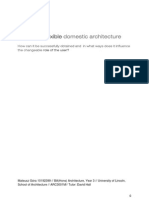Swasti Sthapak
Swasti Sthapak
Uploaded by
Sreya SureshCopyright:
Available Formats
Swasti Sthapak
Swasti Sthapak
Uploaded by
Sreya SureshOriginal Title
Copyright
Available Formats
Share this document
Did you find this document useful?
Is this content inappropriate?
Copyright:
Available Formats
Swasti Sthapak
Swasti Sthapak
Uploaded by
Sreya SureshCopyright:
Available Formats
ISSN: 2277-9655
[Sthapak* et al., 6(12): December, 2017] Impact Factor: 4.116
IC™ Value: 3.00 CODEN: IJESS7
IJESRT
INTERNATIONAL JOURNAL OF ENGINEERING SCIENCES & RESEARCH
TECHNOLOGY
THERMAL COMFORT IN VERNACULAR COURTYARD HOUSES: CASE STUDY
-CHHATTISGARH
Swasti Sthapak*1, Dr. Abir Bandyopadhyay2
*
Department of Architecture, National Institute of Technology Raipur, India
DOI: 10.5281/zenodo.1130828
ABSTRACT
The paper firstly introduces vernacular architecture and defines thermal comfort. The second section of this
paper gives an account of the way vernacular houses respond to climate and achieve thermal comfort.
Vernacular houses of Chhattisgarh, a central state of India are selected for this study to find the evidence that
vernacular architecture is likely to be passively comfortable. Courtyards play a vital role in creating thermal
comfort along with other social and cultural roles. Vernacular houses are more environment- friendly because
they are evolved through a continuous process.
KEYWORDS: Vernacular Architecture; Thermal Comfort; weather; courtyard houses.
I. INTRODUCTION
Vernacular architecture is influenced by a great range of different aspects of human behavior and environment,
leading to differing building forms for almost every different context. The way of life of building occupants, and
the way they use their shelters, is of great influence on building forms. The size of households, who shares the
spaces, way of food preparation, the way of interaction within and between the families and many other cultural
considerations affect the layout and size of dwellings.
II. VERNACULAR ARCHITECTURE
Vernacular buildings record lifestyles of the past when people had to find a sustainable way of life or perish.
The new importance of vernacular building is that it has vital ecological lessons for today [1]. Vernacular
architecture also embodies the local lifestyle and its process of evolution is completely unconscious [2]. These
quotes describe some of the salient attributes of vernacular buildings. Vernacular is strongly tied to cultural and
social traditions. It responds to ambient environmental conditions, and it is, in a way, a naturally evolving
process.
Vernacular architecture comprises all buildings, not just dwellings and relates to environmental contexts and
available resources. These are customarily owner or community built and use traditional technologies.
Vernacular architecture is built to meet specific needs, while accommodating the values, economies, and ways
of life of the cultures that produce them [3]. The word ‘vernacular’ derives from the Latin word ‘vernaculus’
which means native. Hence vernacular architecture refers to ‘native science of building.’ Vernacular architecture
is both regionally and socially specific. Each community over the years develops a prototype that responds to
local needs and carries it forward through generations [4].
Vernacular architecture is a replica of its surrounding social, cultural and environmental needs. In 1969,
Rapoport introduces vernacular architecture as a folk tradition that is a ‘direct and unself-conscious translation
into physical form of a culture, its need and values – as well as the desires, dreams and passions of the people.’
There are two type of categories for these folk traditions; (i) Pre-industrial vernacular and (ii) Modern/Post-
industrial vernacular.
Pre-Industrial Vernacular Architecture
It is a direct reaction of the community that understands its own spatial needs and requirements; solutions to
these problems are handed down through verbal transfer of knowledge through generations. Mostly these houses
are built by their owners with very simple construction technique and details of construction are easy to
understand and accept with minimum alien requirement. It can be taught by one generation to another. The
http: // www.ijesrt.com © International Journal of Engineering Sciences & Research Technology
[487]
ISSN: 2277-9655
[Sthapak* et al., 6(12): December, 2017] Impact Factor: 4.116
IC™ Value: 3.00 CODEN: IJESS7
outcome of there response tends to be very tradition oriented, and the houses follow a uniform model. Thus, it
refers to buildings built by the community and involves no specialized trades[5].
Post-Industrial Vernacular Architecture
After industrial revolution vernacular architecture changed its shape to develop something new that has use of
new building material and its techniques. These new material and techniques required specialized skills. A new
set of considerable conception, design, and construction evolve in this era. As specialized building trades
emerged, the occupants sought help from them to construct buildings. The occupants of these kinds of houses,
although not active participants in the construction, are not just mere users but provide inputs to the design and
construction of the house. Individual variability is thus witnessed in these houses; however, because a society is
bound by traditions, the differences fall within a frame of common heritage and values. These often lack
ostentatious aesthetic display as they try to solve problems in the simplest possible manner, working with the
site and micro-climate, respecting other members of the community and the environment [5].
From the very beginning, shelters have been guided by the climate of the region. Vernacular solutions show a
variety of designs related to the conditions that surround it, responding to the nature, culture, symbolic
interpretations, and definition of comfort in that area [5]. These solutions vary from place to place, usually being
governed by culture even while responding to the similar conditions: the definition of comfort changes from
culture to culture. Hence, considerate thermal comfort is significant because it varies from one another [6].
III. THERMAL COMFORT
ASHRAE Standard 55-2004 defines thermal comfort as “the condition of mind that expresses satisfaction with
the thermal environment.” The thermal environment is those characteristics of the environment which affect a
person's heat loss or gain. According to [7]the variables that affect the thermal comfort most are (i) Activity
level (heat produced in the body) (ii) Thermal resistance of the clothing (clo-value)(iii) Mean radiant
temperature(iv) Air velocity (v) Humidity. Activity level is directly related to the metabolism of the body, which
in turn produces heat. For example, the body of an exercising person will be hotter than a sleeping person.
Hence, the activity directly relates to the thermal level of the body and to the thermal comfort temperature.
Clothing also affects body temperature and exposure to air. All other things being equal, a person wearing a
woolen jacket will be warmer-than someone wearing a t-shirt; i.e., the jacket has a higher clo-value, a measure
of clothing insulation. Apart from keeping the body warm, the clothing also affects evaporative cooling by
preventing convective air from moving over the body surface. Air temperature refers to the sensible temperature
of the air, i.e., temperature that the sensory mechanism of humans can recognize. Radiant temperature refers to
the area-weighted mean temperature of all the objects surrounding the body. Even though not in direct contact
with body, hot or cold objects affect the perception of temperature as they exchange radiant energy. Air
movement is very important for comfort. It can either create comfort or discomfort depending on climatic
conditions. In hot enclosed spaces, no air movement leads to stuffiness; while in cold conditions, even the
slightest air movement may cause discomfort (draftiness). Humidity is another major variable that affects the
comfort condition. Humans automatically sweat to maintain body temperature; higher humidity reduces the
ability of sweating to maintain homeostasis; sweat no longer evaporates to cool the body.
Thermal comfort indoors depends on various factors such as temperatures, humidity, wind speed and thermal
sensation. It differs from place to place according to the location, requirements of the people and the use of the
particular space. Another definition of thermal comfort is the absence of thermal discomfort, that is to say, that
an individual feels neither too warm nor too cold [8]. For indoor conditions, comfort zones are typically
implemented to satisfy 80% of people. The comfort zone is often expressed as a temperature range around the
neutral temperature.
Our modern solutions to climatic problems often do not work, and our homes are made bearable by means of
mechanical means whose cost sometimes exceeds that of the building shell. Primitive and pre-industrial builders
cannot take this attitude, since they lacked in the technology to allow them to ignore climate in design. They
solve their problems by collaborating with nature.- (Rapoport, 1969). The quote emphasizes that comfort
conditions are achieved in vernacular houses without using mechanical means.[9] and [10] state that vernacular
architecture evolves over time after trial and error, and the final form that emerges in a particular culture is
highly responsive to climate and available resources. These successful solutions to the problems of the climate
did not come from deliberate scientific reasoning but from countless experiments and accidents and the
http: // www.ijesrt.com © International Journal of Engineering Sciences & Research Technology
[488]
ISSN: 2277-9655
[Sthapak* et al., 6(12): December, 2017] Impact Factor: 4.116
IC™ Value: 3.00 CODEN: IJESS7
experience of generations of builders who continued to use what worked and rejected what did not [11]In many
regions, vernacular forms can be traced back over hundreds or thousands of years, providing occupants with
comfortable conditions. Dr.Walter B. Cannon stated “the development of a nearly thermo-stable state in our
buildings should be regarded as one of the most valuable advances in the evolution of buildings.” [12]
Studies show that vernacular architecture uses less energy than contemporary architecture.[13] studied the
principles of traditional Indian architecture. After examining different cases from different regions of the Indian
subcontinent for their climatic context, he concluded that vernacular buildings have less need for energy than
contemporary buildings. [14]whose study in Ethiopia on the differences between traditional, vernacular, and
modern buildings in material used, concluded that contemporary buildings neglect some essential environmental
human requirements. He suggests variables that could be used in modern architecture to lower external energy
requirements in the house. Some studies have suggested that vernacular architecture has high thermal
performance, creating comfortable indoor conditions. Studied climatically responsive indigenous buildings and
settlements in the two desert conditions of India, i.e., hot-dry desert of Jaisalmer and cold-dry desert of Leh.
Their study found high thermal performance among these buildings. Another study showed that traditional mud
houses create thermal comfort[15]. The study investigates thermal comfort attitudes of those dwelling in
traditional mud houses. Their survey shows that 90.6% inhabitants of mud houses find them to be comfortable
without artificial cooling and ventilation.
Studies have even showed that vernacular homes use various passive strategies to create comfortable conditions
inside them. For example, courtyard homes in Kolkata use geometry to capitalize on shade and ventilation[6].
Conducted a study in Kolkata on the courtyard houses specifically focusing on the roles of solar shading and
natural ventilation in courtyards
IV. COURTYARDS IN TRADITIONAL HOUSES
Courtyards houses are one of the oldest typologies of shelter making. In all ancient civilizations we find
Courtyard houses as most prevalent type. The courtyards offer multiple advantages ranging from climatic, social
to multiple uses of spaces. In this type of houses, the courtyards are the focal point of all the activities. Most of
the rooms of the house have a direct connection with the courtyard. Along with providing maximum interior
relationship, Courtyards also served privacy purposes by helping to segregate indoors and outdoors.
The courtyards serve as important family gathering spaces. They also play an important role in allowing air
flow and maintaining thermal comfort in living spaces. The shape of the courtyard is mostly generated by
placement of rooms or buildings around it. Air circulation due to these courtyards relies largely on the
proportions of the surrounding walls and positioning of window openings in the surrounding rooms. Shading in
the courtyard helps in creating comfortable living conditions during day and sleeping conditions during night.
V. ROLE OF COURTYARDS IN TRADITIONAL HOUSES OF CHHATTISGARH
Courtyard plays an important role in the houses of Chhattisgarh, India. This state is situated in central part of
India. The climate of Chhattisgarh is tropical. It is hot and humid. Summer temperatures in Chhattisgarh are
very high. The monsoon season is from late June to October. The basic typology of traditional houses in
Chhattisgarh is courtyard houses.
The courtyards have sometimes two three or all four sides’ corridors and rooms. The size of courtyard and
number of rooms depend mostly on the size of family and economic structure of the family. In the front façade
of the house It has a lot of empty space known as ”Bayara”
Verandah next to the front door is generally used for sitting purpose known as “Baithak”. There is mostly mud
flooring in veranda
h. The level of door at threshold is quite above the ground. From the verandah generally there is door to kitchen
and bedrooms. Mud flooring or Cement flooring is used in courtyard. The courtyard is generally at centre of the
house. Sometimes the verandah is also used as kitchen or for sitting purpose. There is a way like a corridor to
the “Gaushala” or the cow shelter and store. Generally bamboo is used for roofing which also provides light to
carry out day to day activities. Generally windows in the wall are very small handmade country tiles are used for
roofing over wooden king post truss. Wooden binders, joists and planks were used to create separation between
attic and leaving space.
http: // www.ijesrt.com © International Journal of Engineering Sciences & Research Technology
[489]
ISSN: 2277-9655
[Sthapak* et al., 6(12): December, 2017] Impact Factor: 4.116
IC™ Value: 3.00 CODEN: IJESS7
A study was done in twenty houses of Bhaismuda village and the plan form, position of courtyard, it’s relation
with other rooms and usage pattern was studied. Major findings of the study are as under:
Courtyards play an important role in allowing air flow and maintaining thermal comfort in living
spaces.
The shape of the courtyard is mostly generated by placement of rooms or buildings around it.
Air circulation due to these courtyards relies largely on the proportions of the surrounding walls and
positioning of window openings in the surrounding rooms.
It was found that the courtyard turned into most active space of the house in the comfort hours.
Shading in the courtyard helps in creating comfortable living conditions during day and sleeping
conditions during night.
Use of courtyard changes in different hours and it also changes in the seasons like in winter corner of
courtyard start working as kitchen at day time but in summer it act as place of sleeping at night hours.
Thermal Comfort in these houses can be seen through the pattern of usage of the spaces.
VI. CONCLUSION
Vernacular houses had been constructed with some underlying principles conveyed from one generation to
other, to make it respond positively to the prevailing climatic conditions and thus helped to attain thermal
comfort without using any mechanical means. These lessons are always contemporary in nature and these can
help in designing contemporary buildings to behave thermally well. In broader perspective this can help in
reducing energy requirements and thus contributing towards a more sustainable future.
VII. REFERENCES
[1] M. Rashid and D. Rahat, “Modernity in tradition : Re fl ections on building design and technology in the
Asian vernacular,” pp. 46–55, 2015.
[2] T. Kamiya, The GUIDE to the ARCHITECTURE of the Indian Subcontinent. Goa: Architecture
Autonomous (Gerard Da Cunha), 2003.
[3] P. Oliver, Dwellings: The House Across the World. University of Texas Press, 1987.
[4] P. Oliver, Built to Meet Needs: Cultural Issues in Vernacular Architecture. Routledge, 2006.
[5] A. Rapoport, House Form and Cultua. New Delhi: Prentice-hall of India Private Ltd, 1969.
[6] N. Das, “Courtyards Houses of Kolkata : Bioclimatic , Typological and Socio-Cultural Study by
Nibedita Das Submitted in partial fulfillment of the requirements for the degree Department of
Architecture,” Birla Institute of Technology, India, 2001, 2006.
[7] P. Fanger, Thermal comfort-analysis and applications in environmental engineering. Copenhagen:
Danish Technical Press, 1970.
[8] J. L. M. Hensen, “Literature review on thermal comfort in transient conditions,” Build. Environ., vol.
25, no. 4, pp. 309–316, 1990.
[9] L. Peeters, R. de Dear, J. Hensen, and W. D’haeseleer, “Thermal comfort in residential buildings:
Comfort values and scales for building energy simulation,” Appl. Energy, vol. 86, no. 5, pp. 772–780,
2009.
[10] I. Cooper and B. Dawson, Traditional Buildings of India. 1998.
[11] A. S. Dili, M. A. Naseer, and T. Z. Varghese, “Thermal comfort study of Kerala traditional residential
buildings based on questionnaire survey among occupants of traditional and modern buildings,” Energy
Build., vol. 42, no. 11, pp. 2139–2150, 2010.
[12] J. Gupta and M. Chakraborty, “The need for vernacular mud huts of Ranchi to adapt to the changing
climate of Ranchi,” Int. J. Environ. Stud., vol. 73, no. 4, pp. 584–603, 2016.
[13] D. Vyas, “Traditional Indian architecture-the future solar buildings,” Int. Conf. Passiv. Low Energy …,
no. May, pp. 699–704, 2005.
[14] A. Gautam, “Climate Responsive Vernacular Architecture: Jharkhand, India,” p. 147, 2008.
[15] M. Chakraborty and J. Gupta, “The need for vernacular mud huts of Ranchi to adapt to the changing
climate of Ranchi,” J. Int. J. Environ. Stud., vol. 73, no. 4, 2016.
CITE AN ARTICLE
http: // www.ijesrt.com © International Journal of Engineering Sciences & Research Technology
[490]
ISSN: 2277-9655
[Sthapak* et al., 6(12): December, 2017] Impact Factor: 4.116
IC™ Value: 3.00 CODEN: IJESS7
http: // www.ijesrt.com © International Journal of Engineering Sciences & Research Technology
[491]
You might also like
- Literature Review - A Sustainable Vernacular ArchitectureDocument5 pagesLiterature Review - A Sustainable Vernacular ArchitectureResti PiutantiNo ratings yet
- Frei Otto, Bodo Rasch: Finding FormDocument15 pagesFrei Otto, Bodo Rasch: Finding FormIgor Stati100% (3)
- Final Year Project - Viva PresentationDocument23 pagesFinal Year Project - Viva PresentationMalik SaifulNo ratings yet
- Ark AngelDocument172 pagesArk AngelCrina Serban67% (6)
- Catalogo XT250-16 EEC PDFDocument40 pagesCatalogo XT250-16 EEC PDFtgjoiNo ratings yet
- Ecological Building DesignDocument13 pagesEcological Building DesignGunk RaditNo ratings yet
- Casa IbalonDocument13 pagesCasa IbalonAmabelle SerranoNo ratings yet
- Wioletta Sarara P5 ResearchPaper1 BioclimaticDesignDocument41 pagesWioletta Sarara P5 ResearchPaper1 BioclimaticDesignHadia ANo ratings yet
- Theory of ArchitectureDocument18 pagesTheory of ArchitectureMatthew DeononNo ratings yet
- The Use of Traditional Courtyard Design in Libyan Housing As A Way For A Sustainable DesignDocument15 pagesThe Use of Traditional Courtyard Design in Libyan Housing As A Way For A Sustainable DesignSumbalFiazNo ratings yet
- Effective Thermal Insulation - The Operative Factor of A Passive Building ModelDocument112 pagesEffective Thermal Insulation - The Operative Factor of A Passive Building ModelJosé RamírezNo ratings yet
- Green ConstructionDocument11 pagesGreen ConstructionJay-ra DaligdigNo ratings yet
- An Evolutionary Architecture:: Adapted, Interactive, and Effectively Integrated DesignDocument6 pagesAn Evolutionary Architecture:: Adapted, Interactive, and Effectively Integrated DesignAntonio C. KeithNo ratings yet
- Universalism Vs Rationalism WpsDocument7 pagesUniversalism Vs Rationalism WpsAbi TesemaNo ratings yet
- BuildingAZeroEnergyforUAE ZEMCH 2016 International Conference Proceedings 10MB.56161853Document11 pagesBuildingAZeroEnergyforUAE ZEMCH 2016 International Conference Proceedings 10MB.56161853عمار كريمNo ratings yet
- 06 Chapter 1Document15 pages06 Chapter 1GayathriNo ratings yet
- Adaptive Vernacular For Sustainability Lessons From South AsiaDocument14 pagesAdaptive Vernacular For Sustainability Lessons From South AsiaManish BokdiaNo ratings yet
- Critical Thinking in Teaching Sustainable ArchitectureDocument7 pagesCritical Thinking in Teaching Sustainable ArchitectureShofirah AzkiahNo ratings yet
- Vernacular ArchitectureDocument15 pagesVernacular ArchitectureDivya ShanmugasundaramNo ratings yet
- Synopsis Feedback - RashiDocument3 pagesSynopsis Feedback - RashiRashi KondwilkarNo ratings yet
- Sustainable Adaptation Climate of Traditional Buildings Te 2016 Procedia EngDocument8 pagesSustainable Adaptation Climate of Traditional Buildings Te 2016 Procedia EngPaul Martin Dela CruzNo ratings yet
- Architecting A Sustainable Tomorrow: Principles of Green Building DesignDocument4 pagesArchitecting A Sustainable Tomorrow: Principles of Green Building DesignInternational Journal of Innovative Science and Research TechnologyNo ratings yet
- Review of Related Literature and Related StudiesDocument11 pagesReview of Related Literature and Related Studiescool joeNo ratings yet
- Current Problems With Architecture: InefficiencyDocument9 pagesCurrent Problems With Architecture: InefficiencyNeetu SharmaNo ratings yet
- Flexible Housing The Role of Spatial Organization in Achieving Functional EfficiencyDocument13 pagesFlexible Housing The Role of Spatial Organization in Achieving Functional EfficiencySamar BelalNo ratings yet
- Passive Cooling Techniques in Historical Building Versus Contemporary Bio Mimic Concepts: An OverviewDocument10 pagesPassive Cooling Techniques in Historical Building Versus Contemporary Bio Mimic Concepts: An Overviewdocwit10No ratings yet
- CAMPUED - JOHN PAUL - Written Report 02Document32 pagesCAMPUED - JOHN PAUL - Written Report 02John Paul CampuedNo ratings yet
- Adaptive/Flexible Domestic ArchitectureDocument23 pagesAdaptive/Flexible Domestic ArchitectureMateusz Góra100% (3)
- Tropical Architecture: Basic Design PrinciplesDocument27 pagesTropical Architecture: Basic Design PrinciplesChristian Villena100% (3)
- Sustainable Building Solution A Review Oflessons FromDocument10 pagesSustainable Building Solution A Review Oflessons FromEng.Maitham AlsaffarNo ratings yet
- Bioclimatic ArchitecturepublishedDocument13 pagesBioclimatic ArchitecturepublishedRafael FernandoNo ratings yet
- Progress in thermal comfort research over the last twenty yearsDocument20 pagesProgress in thermal comfort research over the last twenty yearsAdam TylerNo ratings yet
- Part 2Document10 pagesPart 2KeishaNo ratings yet
- Climate Change Adopted Building Envelope by Krystyna Januszkiewicz and Natalia PaszkowskaDocument9 pagesClimate Change Adopted Building Envelope by Krystyna Januszkiewicz and Natalia PaszkowskaKrystynaNo ratings yet
- The Academic Research Community PublicationDocument21 pagesThe Academic Research Community PublicationJoseph Carmelo Andres RagadiNo ratings yet
- Civil Engineering Part 2Document25 pagesCivil Engineering Part 2Yulia PhilippovaNo ratings yet
- Vernacular Architecture: Definition, Principles and Energy ConservationDocument8 pagesVernacular Architecture: Definition, Principles and Energy ConservationGabby CadalinNo ratings yet
- Plea2006 Paper151Document5 pagesPlea2006 Paper151Anisza RatnasariNo ratings yet
- A Study On Regenerative Architecture: February 2019Document14 pagesA Study On Regenerative Architecture: February 2019Nihit SandNo ratings yet
- Philippines Part 1 Copy 2Document3 pagesPhilippines Part 1 Copy 2Marietta O. GermanNo ratings yet
- Housing in CHinaDocument4 pagesHousing in CHinaRONAKK JAINNo ratings yet
- Reinterpretation of Energy Efficiency in Thomas Herzog's ArchitectureDocument18 pagesReinterpretation of Energy Efficiency in Thomas Herzog's ArchitectureMattute JerezNo ratings yet
- The Basic Principles of Ecovillage DesignDocument9 pagesThe Basic Principles of Ecovillage DesignnoricumNo ratings yet
- 4 SamraKhanDocument12 pages4 SamraKhanXahid UsmanNo ratings yet
- Research: Elements That Contribute To Healthy Building DesignDocument6 pagesResearch: Elements That Contribute To Healthy Building DesignAuliya SalmaNo ratings yet
- LIGHT11008FU1Document12 pagesLIGHT11008FU1Mahamud MusaNo ratings yet
- Climatic Responsiveness of The Vernacular Houses Towards Developing A Passive Design Sense For Architecture To Reduce Energy Dependency - Case StudyDocument5 pagesClimatic Responsiveness of The Vernacular Houses Towards Developing A Passive Design Sense For Architecture To Reduce Energy Dependency - Case StudyInternational Journal of Innovative Science and Research TechnologyNo ratings yet
- Flexible Architecture: Optimization of Technology and CreativityDocument12 pagesFlexible Architecture: Optimization of Technology and CreativityZeba NisarNo ratings yet
- NARRATIVE Report - Architectural DesignDocument6 pagesNARRATIVE Report - Architectural DesignVanessa OchavilloNo ratings yet
- Housing Exibility Problem: Review of Recent Limitations and SolutionsDocument12 pagesHousing Exibility Problem: Review of Recent Limitations and SolutionsWilmer Alexsander Pacherrez FernandezNo ratings yet
- Bioclimatic Architecture and CyprusDocument286 pagesBioclimatic Architecture and CyprusPetros LapithisNo ratings yet
- Moving Towards GreenDocument10 pagesMoving Towards GreenFer Casanova SotoNo ratings yet
- Irjet V4i1163 PDFDocument6 pagesIrjet V4i1163 PDFSEJAL JAINNo ratings yet
- Engineering Capstone Paper - Green ArchitectureDocument11 pagesEngineering Capstone Paper - Green Architectureapi-373230511No ratings yet
- Green ConstructionDocument19 pagesGreen ConstructionJohn ChristopherNo ratings yet
- Jubril 1&2Document9 pagesJubril 1&2jtomiwa80No ratings yet
- Seyed Morteza Moossavi Adaptive Thermal Comfort ModelDocument9 pagesSeyed Morteza Moossavi Adaptive Thermal Comfort ModelSri sandhiya sankarNo ratings yet
- Essential Building Science: Understanding Energy and Moisture in High Performance House DesignFrom EverandEssential Building Science: Understanding Energy and Moisture in High Performance House DesignRating: 4.5 out of 5 stars4.5/5 (2)
- Green Architecture: A Guide To Understanding Characteristics of Sustainable BuildingsFrom EverandGreen Architecture: A Guide To Understanding Characteristics of Sustainable BuildingsNo ratings yet
- Ecological Engineering Design: Restoring and Conserving Ecosystem ServicesFrom EverandEcological Engineering Design: Restoring and Conserving Ecosystem ServicesNo ratings yet
- History of Sustainable Interior Design: A Comprehensive Guide to Evolution of Sustainable Interior DesignFrom EverandHistory of Sustainable Interior Design: A Comprehensive Guide to Evolution of Sustainable Interior DesignNo ratings yet
- Content Creation Instruction Design: & With Ethos!Document3 pagesContent Creation Instruction Design: & With Ethos!Sreya SureshNo ratings yet
- QWWWWWWWDocument2 pagesQWWWWWWWSreya SureshNo ratings yet
- FFDocument2 pagesFFSreya SureshNo ratings yet
- Museum Architecture Matters PDFDocument13 pagesMuseum Architecture Matters PDFSreya SureshNo ratings yet
- SynopsisDocument4 pagesSynopsisSreya Suresh100% (1)
- Living and Learning Center For Handloom KannurDocument6 pagesLiving and Learning Center For Handloom KannurSreya SureshNo ratings yet
- COMPARITATIVE ANALYSIS Case StudyDocument1 pageCOMPARITATIVE ANALYSIS Case StudySreya SureshNo ratings yet
- Living and Learning Center For Handloom KannurDocument6 pagesLiving and Learning Center For Handloom KannurSreya Suresh0% (1)
- Compilation of Lesson Plan (Group 4)Document37 pagesCompilation of Lesson Plan (Group 4)Rey Dimalanta Gloria100% (1)
- List of Abbreviations Used in Medical PrescriptionsDocument7 pagesList of Abbreviations Used in Medical PrescriptionsМарија Рашковска100% (1)
- 2016 Feng Shui Chart of The Flying StarsDocument6 pages2016 Feng Shui Chart of The Flying StarsTashi MarieNo ratings yet
- ICC Special Inspector Exam Training Manual - 2008Document29 pagesICC Special Inspector Exam Training Manual - 2008Brian HowellNo ratings yet
- Insolvency Tutorial QuestionsDocument2 pagesInsolvency Tutorial QuestionsRoletta Van StadenNo ratings yet
- The Role of Micro and Smallscale Enterprises in Poverty Reduction: The Case of Dugda Dewa Woreda Finchawa Town Southern EthiopiaDocument20 pagesThe Role of Micro and Smallscale Enterprises in Poverty Reduction: The Case of Dugda Dewa Woreda Finchawa Town Southern Ethiopiaiaset123No ratings yet
- Dispensers of CaliforniaDocument1 pageDispensers of Californiariya lakhotia0% (1)
- Planificaciones de Ingles y CTSDocument17 pagesPlanificaciones de Ingles y CTSspinel gemNo ratings yet
- Con PlanDocument52 pagesCon PlanIntergalactic MaximusNo ratings yet
- Year 6 Animals Including Humans Revision Activity MatDocument8 pagesYear 6 Animals Including Humans Revision Activity MatAvaPlaysYTNo ratings yet
- GCSE PhysicsDocument31 pagesGCSE PhysicsOliver Johnston-WattNo ratings yet
- Introduction To Peptides in Cosmetic Science 1701831851Document8 pagesIntroduction To Peptides in Cosmetic Science 1701831851csk86No ratings yet
- 2015 LTSM Catalogue Grades 1-3Document13 pages2015 LTSM Catalogue Grades 1-3Immaculate UmaNo ratings yet
- Sigma Guard CoatingDocument6 pagesSigma Guard CoatingAnonymous YcAZv5qF67No ratings yet
- Media Management Cases and Analysis by Ameyu EtanaDocument17 pagesMedia Management Cases and Analysis by Ameyu EtanaAmeyu Etana KaloNo ratings yet
- Wipro Oracle R12 White Paper 2111Document10 pagesWipro Oracle R12 White Paper 2111rajkumarNo ratings yet
- Scouts and Nature: "Nature Study Is The Key Activity in Guiding and Scouting"-Baden PowellDocument5 pagesScouts and Nature: "Nature Study Is The Key Activity in Guiding and Scouting"-Baden PowellDinnar Diandra ATNo ratings yet
- ARIVU QAQC ENG Curriculum VitaeDocument3 pagesARIVU QAQC ENG Curriculum Vitaearivazhaganverger2018No ratings yet
- Bros and ConsDocument25 pagesBros and ConsHarrisonFordFocusNo ratings yet
- Constructing A User Interface With AngularDocument83 pagesConstructing A User Interface With AngularshyamVENKATNo ratings yet
- Bonding in OrthodonticsDocument111 pagesBonding in OrthodonticsDr.Varun Shankar100% (1)
- Session 415 - Debugging With LLDBDocument436 pagesSession 415 - Debugging With LLDBfoufoutos730% (1)
- Data Architect or ETL ArchitectDocument4 pagesData Architect or ETL Architectapi-78843572No ratings yet
- Module 3 - Preferential TaxationDocument8 pagesModule 3 - Preferential Taxationsweetzaira.madejanonNo ratings yet
- Group 5 Case Study 2Document4 pagesGroup 5 Case Study 2Md. Shahariar KoushikNo ratings yet
- Form of Application For New Licence To Drive A Motor Vehicle LL DL (Read The Instructions On Page-5 Carefully Before Filling The Form)Document5 pagesForm of Application For New Licence To Drive A Motor Vehicle LL DL (Read The Instructions On Page-5 Carefully Before Filling The Form)Saif Ahmed LariNo ratings yet
- Definition of MotivationDocument7 pagesDefinition of MotivationVaishnavi Reddy JNo ratings yet

































































































